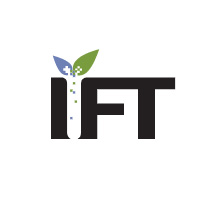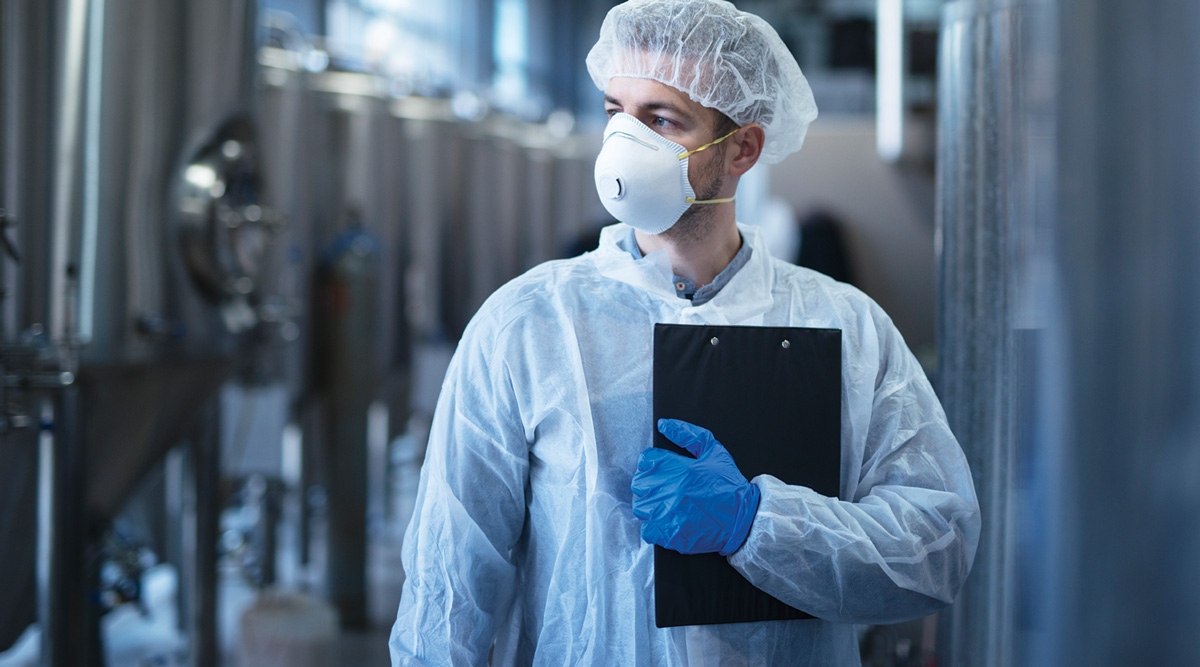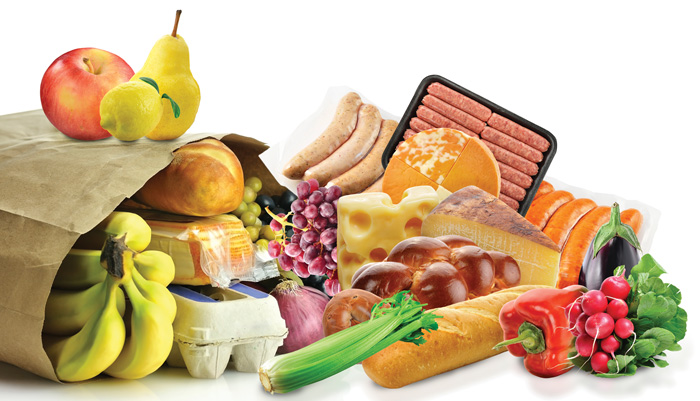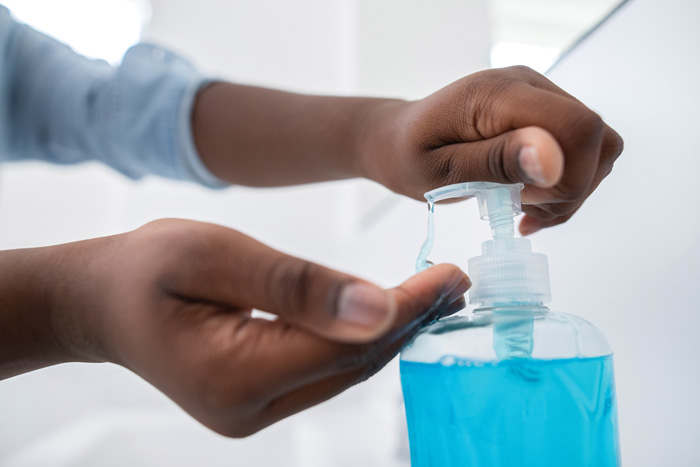
Food Safety During the COVID-19 Pandemic
What food manufacturing, food processing, and food packaging companies should be doing to keep workers safe during the COVID-19 pandemic.
Article Content
As SARS-CoV-2 persists around the globe, public health experts continue to monitor ways in which the virus may be spreading. Because it is a novel coronavirus, scientists’ knowledge of all the ways in which the virus may be spreading is evolving. The most up-to-date scientific evidence indicates that SARS-CoV-2, which causes coronavirus disease 2019 (COVID-19), is not transmissible via food but is transmissible between people who are in close contact with each other. Research indicates that SARS-CoV-2 spreads when people infected with the virus expel droplets while coughing or sneezing, and more recent findings suggest that the virus may also be transmitted when infected people—whether symptomatic or asymptomatic—speak and breathe (Cohen 2020, Lanese 2020).
COVID-19 and the Food Supply
The nation’s food supply is thus susceptible to disruption not by food contaminated with SARS-CoV-2 but by the transmission of the virus among workers in locations and facilities where food is produced, processed, packaged, and sold. “The main concern here is protecting other workers in the operation,” says Martin Bucknavage, senior food safety extension associate, Pennsylvania State University. “As COVID-19 is spread mainly from person to person,” says Olga Padilla-Zakour, professor and director of the Cornell Food Venture Center, Cornell University, “the best ways to avoid the spread among workers is to have clear protocols [(standard operating procedures)] in place for each facility to minimize possible contamination. Farms and food facilities already have [good manufacturing practices] in place; thus, the additional measures needed are to protect workers.” These procedures include training all workers on how the COVID-19 virus is spread, social distancing, and good hygiene protocols: When a person who has COVID-19 coughs, sneezes, speaks, or breathes, he or she emits fluid particles that carry the virus. These infected droplets and aerosols can land on frequently touched surfaces and objects or be directly inhaled by others standing nearby. Workers on farms, in food plants, and in the offices of food companies should therefore maintain a distance of at least six feet between each other. “Eliminate direct personal contact, stagger breaks/meetings to de-densify common areas, physically reset and mark common areas for social distancing, [and] assign work in predetermined group clusters,” Padilla-Zakour advises. When social distancing is not possible in the workplace (for example, because of physical restrictions or established production lines), workers should wear face masks or other face coverings as an additional safeguard.
Besides maintaining distances of six feet between each other and wearing face masks, handwashing and other hygiene measures are incredibly important. All food workers should “wash hands frequently and any time [they] touch a potentially contaminated object,” says Bucknavage, specifying, “Lather and scrub hands and arms for 20 seconds. Be sure to scrub tops of hands and between fingers.” The use of hand sanitizers and disposable gloves is helpful but not as effective against the COVID-19 virus as handwashing. Workers should also avoid touching their faces (i.e., eyes, nose, and mouth) with unwashed hands and stay home if they are sick. “Educate workers on COVID-19 transmission to encourage frequent hand washing/sanitizing and to avoid touching [their] face,” Padilla-Zakour says. Because of the essential work they do, food processing and food packaging facilities should also advise their employees to practice social distancing when they are not working. Employees should “take precautions when not at work,” Bucknavage points out. “Maintain social distancing, … do not shake hands or hug, avoid people who are sick, … and [avoid] groups or places where people congregate.”
Employees Who May Be Positive
SARS-CoV-2 is highly contagious, so employers should tell employees who have COVID-19 symptoms (i.e., fever, cough, and/or shortness of breath) to notify their supervisors and stay home. “Update and enforce sick policies to preclude any sick workers from entering the facilities,” Padilla-Zakour recommends. Employees who live with or have knowingly had contact with one or more family members exhibiting COVID-19 symptoms should notify their supervisors, stay home, and follow guidelines recommended by the U.S. Centers for Disease Control and Prevention (CDC). “They need to remember that even if they have no symptoms or mild symptoms, infected people can still spread the virus,” Bucknavage warns. The CDC recommends that anyone who coughs or sneezes should cover her mouth and nose with a tissue or use the inside of her elbow. Afterwards, the person should immediately throw the used tissue in the trash and wash her hands with soap and water.
In the event a worker is confirmed by a laboratory to be positive for COVID-19, Padilla-Zakour says that the company must immediately notify the local health department. “The local health department will be involved in monitoring the employee … while symptomatic and under isolation until recovery,” she says. “The local health department will be involved in clearing fully recovered employees from isolation before they can return to work. Any sick employee should follow the CDC’s ‘What to Do if You Are Sick With Coronavirus Disease 2019 (COVID-19).’” All areas where the virus-positive individual worked must be thoroughly cleaned and disinfected, using gloves and face masks. Employers must then inform the person’s coworkers that they may have been exposed to the virus that causes COVID-19 at work while keeping confidential the name of the person who tested positive.
To protect food workers in agriculture, processing facilities, and packaging facilities, each food facility should provide easy and frequent access to liquid soap, water, and alcohol-based hand sanitizers. Surfaces that are frequently touched—such as door handles, light switches, tabletops, workstations, keyboards, control buttons, toilet handles, etc.—must be cleaned and disinfected frequently, using products that the U.S. Environmental Protection Agency deems effective against SARS-CoV-2. Experts advise employers to place disinfecting wipes in rooms frequented by employees so that each employee can wipe down objects and machines after they touch or use them. The novel coronavirus can survive for limited periods of time on various surfaces, including cardboard, paper, and plastic. Published evidence suggests that the virus can survive on hard surfaces such as stainless steel and plastic for up to three days, and on soft surfaces such as cardboard and paper for about a day.
Actions by Food Industry Stakeholders
Flavor and color manufacturer Flavorchem has implemented a robust operational and sanitation plan founded on recommendations by the CDC and federal, state, and local public health experts. “A few highlights from the Flavorchem COVID-19 response plan include sanitizing common touch surfaces like keyboards, door handles, and chairs at least twice during each shift by authorized personnel,” says Laura Dembitzer, Flavorchem’s director of marketing and communications. “The health and wellness of our employees, customers, and partners is our top priority. We are prepared to do whatever is necessary to keep our employees safe and healthy. … As long as we are able, our global operations will continue to function even under the most stringent protocols, so we can do our part to keep supply chains open and support essential food manufacturing.”
Italian food company Veroni has implemented a number of safety precautions outlined in its internal safety and quality plan and international standards since SARS-CoV-2 arrived in Italy. “We are strictly following the government’s special COVID-19 measures,” says Emanuela Bigi, Veroni’s marketing manager. “We have arranged new staggered working shifts. In addition, keeping in line with special COVID-19 measures, we check our employees’ temperature twice a day, plants and offices are periodically sanitized, our back-office team is working from their homes, and our commercial team has a mandatory travel and meeting ban.”
Another food manufacturer says that it is following the most up-to-date recommendations and guidelines from the CDC, the U.S. Food and Drug Administration (FDA), and the Consumer Brands Association. The company’s safety protocols include regular sanitation and social distancing. In addition, the company erected a large heated tent in its parking lot for employees to wait until their shifts start and to take breaks. Hand sanitizer dispensers have been placed near both sides of every door, and cans of disinfecting spray are in every conference room so that employees can wipe down tables and chairs before and after each meeting. The company has suspended its policy for absences so that employees need not feel pressured to show up for work if they feel ill. And in its corporate offices, the company has staggered the days in which employees should be in the office so that the number of employees in the office each day is reduced.
Various universities with food science departments and extension programs have availed a wealth of information online. “The food safety team at [Cornell University’s] Department of Food Science quickly recognized the need to support the food industry,” Padilla-Zakour says. “We created a comprehensive website to provide up-to-date information to the food industry, housed under our Institute for Food Safety. We created a Cornell COVID-19 Emergency Task Force on Food Safety & Processing … to properly and timely address the most critical issues.” The task force is comprised of the university’s food safety experts and food regulatory leaders with the Department of Agriculture and Markets of the State of New York. Cornell University has also been offering industry hours two to three times per week since March 23. The industry hour events are free and allow industry professionals and food inspectors to submit questions to Cornell food safety experts and other participating experts.
Pennsylvania State University has developed materials on food safety and safe operations during the pandemic and placed them on the Penn State extension website (https://extension.psu.edu/coronavirus). “These are based upon CDC and FDA guidance. ‘Preparing Food Processing Operations for Coronavirus’ explains the CDC and WHO guidance for food processors,” Bucknavage says. “The extension services at Penn State and other universities across the country are still operating and are here to provide support to the food industry. While many are working from home, we are still easily accessible.” Other universities providing expert advice, FAQs, extension services, and other food industry resources online are Michigan State University, North Carolina State University, Purdue University, and University of California, Davis.
REFERENCES
Cohen, E. 2020. “Experts Tell White House Coronavirus Can Spread Through Talking or Even Just Breathing.” CNN Health, April 4. https://www.cnn.com/2020/04/02/health/aerosol-coronavirus-spread-white-house-letter/index.html.
Lanese, N. 2020. “COVID-19 May Spread Through Breathing and Talking—but We Don’t Know How Much.” Live Science, April 7. https://www.livescience.com/covid19-coronavirus-transmission-through-speech.html.











